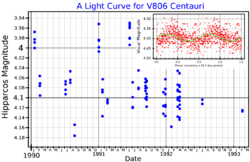Astronomy:2 Centauri
Script error: No such module "About-distinguish".
 A light curve for V806 Centauri. The main plot shows the long term variability from Hipparcos data,[1] and the inset plot shows the variability over the 26.5 day period, using data from Tabur et al. (2009).[2] The green curve shows the best-fit sine wave, which has an amplitude of 18 millimagnitudes. | |
| Observation data Equinox J2000.0]] (ICRS) | |
|---|---|
| Constellation | Centaurus |
| Right ascension | 13h 49m 26.72175s[3] |
| Declination | −34° 27′ 02.7929″[3] |
| Apparent magnitude (V) | 4.19[4] (4.16–4.26)[5] |
| Characteristics | |
| Spectral type | M5 III[6] |
| U−B color index | +1.44[7] |
| B−V color index | +1.49[7] |
| Variable type | SRb[5] |
| Astrometry | |
| Radial velocity (Rv) | +40.7±0.7[8] km/s |
| Proper motion (μ) | RA: −41.68±0.23[3] mas/yr Dec.: −59.77±0.18[3] mas/yr |
| Parallax (π) | 17.82 ± 0.21[3] mas |
| Distance | 183 ± 2 ly (56.1 ± 0.7 pc) |
| Absolute magnitude (MV) | +0.51[9] |
| Details | |
| Radius | 70[10] R☉ |
| Luminosity | 71.96[4] L☉ |
| Temperature | 3,398[11] K |
| Other designations | |
| Database references | |
| SIMBAD | data |
2 Centauri is a single[13] star in the southern constellation of Centaurus, located approximately 183 light-years from Earth.[3] It has the Bayer designation g Centauri;[12] 2 Centauri is the Flamsteed designation. This object is visible to the naked eye as faint, red-hued star with an apparent visual magnitude of 4.19.[4] It is moving away from the Earth with a heliocentric radial velocity of +41 km/s.[8] The star is a member of the HR 1614 supercluster.[14]
This is an evolved red giant star with a stellar classification of M5 III.[6] It is classified as a semiregular variable star and its brightness varies from magnitude +4.16 to +4.26[5] with a period of 12.57 days.[15] The star has around 70[10] times the Sun's radius and is radiating 72[4] times the Sun's luminosity from its enlarged photosphere at an effective temperature of 3,398 K.[11]
References
- ↑ "Hipparcos Tools Interactive Data Access". ESA. https://www.cosmos.esa.int/web/hipparcos/interactive-data-access.
- ↑ Tabur, V.; Bedding, T. R.; Kiss, L. L.; Moon, T. T.; Szeidl, B.; Kjeldsen, H. (2009). "Long-term photometry and periods for 261 nearby pulsating M giants". Monthly Notices of the Royal Astronomical Society 400 (4): 1945–1961. doi:10.1111/j.1365-2966.2009.15588.x. Bibcode: 2009MNRAS.400.1945T.
- ↑ 3.0 3.1 3.2 3.3 3.4 3.5 van Leeuwen, F. (2007). "Validation of the new Hipparcos reduction". Astronomy and Astrophysics 474 (2): 653–664. doi:10.1051/0004-6361:20078357. Bibcode: 2007A&A...474..653V. Vizier catalog entry
- ↑ 4.0 4.1 4.2 4.3 Anderson, E.; Francis, Ch. (2012). "XHIP: An extended hipparcos compilation". Astronomy Letters 38 (5): 331. doi:10.1134/S1063773712050015. Bibcode: 2012AstL...38..331A.
- ↑ 5.0 5.1 5.2 Samus, N. N. et al. (2009). "VizieR Online Data Catalog: General Catalogue of Variable Stars (Samus+ 2007-2013)". VizieR On-line Data Catalog: B/GCVS. Originally Published in: 2009yCat....102025S 1. Bibcode: 2009yCat....102025S.
- ↑ 6.0 6.1 Houk, N.; Swift, C. (1999). "Michigan catalogue of two-dimensional spectral types for the HD Stars, Vol. 5". Michigan Spectral Survey 5. Bibcode: 1999MSS...C05....0H.
- ↑ 7.0 7.1 Mermilliod, J.-C. (1986). "Compilation of Eggen's UBV data, transformed to UBV (unpublished)". Catalogue of Eggen's UBV Data. Bibcode: 1986EgUBV........0M.
- ↑ 8.0 8.1 Gontcharov, G. A. (2006). "Pulkovo Compilation of Radial Velocities for 35 495 Hipparcos stars in a common system". Astronomy Letters 32 (11): 759–771. doi:10.1134/S1063773706110065. Bibcode: 2006AstL...32..759G.
- ↑ Cardini, D. (January 2005), "Mg II chromospheric radiative loss rates in cool active and quiet stars", Astronomy and Astrophysics 430: 303–311, doi:10.1051/0004-6361:20041440, Bibcode: 2005A&A...430..303C.
- ↑ 10.0 10.1 Pasinetti Fracassini, L. E. et al. (February 2001). "Catalogue of Apparent Diameters and Absolute Radii of Stars (CADARS)". Astronomy and Astrophysics 367: 521–524. doi:10.1051/0004-6361:20000451. Bibcode: 2001A&A...367..521P.
- ↑ 11.0 11.1 McDonald, I. et al. (2012), "Fundamental parameters and infrared excesses of Hipparcos stars", Monthly Notices of the Royal Astronomical Society 427 (1): 343–357, doi:10.1111/j.1365-2966.2012.21873.x, Bibcode: 2012MNRAS.427..343M
- ↑ 12.0 12.1 "2 Cen". SIMBAD. Centre de données astronomiques de Strasbourg. http://simbad.u-strasbg.fr/simbad/sim-basic?Ident=2+Cen.
- ↑ Eggleton, P. P.; Tokovinin, A. A. (September 2008). "A catalogue of multiplicity among bright stellar systems". Monthly Notices of the Royal Astronomical Society 389 (2): 869–879. doi:10.1111/j.1365-2966.2008.13596.x. Bibcode: 2008MNRAS.389..869E.
- ↑ Eggen, Olin J. (June 1998). "The HR 1614 Group and HIPPARCOS Astrometry". The Astronomical Journal 115 (6): 2453–2458. doi:10.1086/300380. Bibcode: 1998AJ....115.2453E.
- ↑ Ruban, E. V.; Arkharov, A. A.; Hagen-Thorn, E. I.; Novikov, V. V. (September 2009). "Physical parameters of the semiregular variable red giant 2 Cen". Astrophysics 52 (3): 383–394. doi:10.1007/s10511-009-9075-3. Bibcode: 2009Ap.....52..383R.
 |

